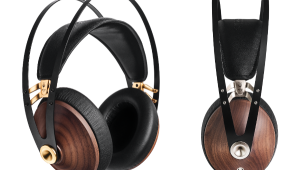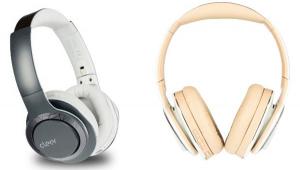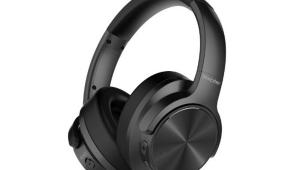Review: MrSpeakers Mad Dog Alpha
"So this is a tuner headphone," our frequent West Coast listening panelist Will Huff commented when I showed him the Mad Dog Alpha. "Like tuner cars?" he suggested when he saw my quizzical look. "Like in Fast and Furious?" he asked when I gave him a shrug. Ah, finally I got it.
The MrSpeakers Mad Dog Alpha is indeed a tuner headphone. Just as guys will buy a stock Honda Civic, then get better performance out of it by replacing the exhaust, the camshaft, etc., MrSpeakers buys a stock Fostex T50RP professional headphone and tweaks it out for improved comfort and better sound.
Fostex's RP series headphones have long been a favorite of recording professionals and some audiophiles, too. When I was recording jazz and folk groups in New York City back in the late 1990s, I bought a T20 to use for monitoring my mixes, and it still sounds great today. RP-series 'phones use an orthodynamic (planar magnetic) driver, smaller than but similar to the ones used in HiFiMan headphones like the HE-400 and HE-500.
To upgrade the T50RP, MrSpeakers first seals the vents in the back, which should give the headphone more bass while maybe losing some of the spaciousness that open-back headphones tend to produce. Then the company tunes the acoustics of the enclosure through strategic application of felt, foam, and fibrous stuffing. Then it adds plush, angled leather pads reminiscent of those we saw on Audeze's $1,999 LCD-3, and supplements the stock Fostex band with a second leather strap intended to help support the weight of the headphones and keep them from drooping down on your ears.
"Spectacular comfort," Will raved. "They're like a La-Z-Boy for your ears."
The Mad Dog Alpha comes with two detachable cords: one with a 3.5mm plug, one with a 6.3mm plug. It also includes a simple velour carrying sack. The headphone originally came with Ralph Steadman-inspired color graphics on the side, but now just says "Mad Dog" in white text-a deeply disappointing move, in our opinion, 'cause the old graphics were so right and the new ones are so boring.
The price for this formerly professional but now fancy audiophile headphone? $299. In comparison, the T50RP lists for $199 but I found it online for $99. Considering that Audeze charges $80 for LCD-3 replacement pads, and that you get that nice strap plus the acoustical tuning mods, $299 seems reasonable. And of course, $299 is an affordable price for an audiophile headphone.
Mad for the Mad Dog?
My fellow Tech^2 blogger Geoff Morrison has a talent for summing things up simply, and he did just that when he listened to the Mad Dog Alpha: "It's like a Grado with balls."
For those who aren't hip to Grado headphones, it's a brand revered by some (and despised by some) for their hyperdetailed sound, which results in part from an emphasis on midrange and treble and a deficit of bass. For decades, they've been a favorite of many audiophiles, but our listening panel's never quite warmed up to them. Not even me, and I've owned two sets of Grados.
So what Geoff was saying was that the Mad Dog Alpha has the hyperdetail and strong treble typical of Grados, but with more bass to balance out the sound. Will agreed: "It's very accurate," he said.
One of my two or three favorite test tracks, Steely Dan's "Aja" (yep, that tune again), showed me exactly what the Mad Dog Alpha was doing. The lead vocal, piano, and rhythm guitar showed just a trace of emphasis in the treble, which gave me a heightened sense of detail. It was extremely easy to pick out the individual instruments in the mix, and each instrument seemed to have its own space around it. The cymbals, cabasa, and triangle (wait, there's a triangle on this tune?) were mildly boosted in the mix. The bass line sounded tight, although I didn't get as much of a sense of groove as I usually do on this tune.
Another one of my overused test tracks, the live version of "Shower the People" from James Taylor's Live at the Beacon Theatre, confirmed my impressions. James's voice sounded just slightly trebly, and ever-so-slightly sibilant, but his acoustic guitar sounded like I was listening from 3 feet away. The glockenspiel in this recording, which I often use to gauge the high-frequency response of speakers and headphones, sounded cleaner and clearer than I've ever heard it before. While I would have appreciated a little more bottom end, the ability to pick out every instrument and every background vocal was pretty compelling.
I have to mention, too, that on the Michael Murray/San Francisco Symphony recording of Jongen's "Symphony Concertante," the strings sounded extremely detailed and lifelike, much as they would if you were sitting in row 1, dead center.
Just out of curiosity, I compared the Mad Dog Alpha to my Grado SR225 and Fostex T20. The SR225 was definitely more Grado-ey than the Mad Dog, with just a tad more treble detail, no low bass to speak of, and what sounded like a pronounced midrange peak that to me made the sound fatiguing. The T20 sounded smoother than the Mad Dog Alpha, and tilted a little more toward the bass, with just a dB or two more bottom end and maybe a dB less treble. It's still a great-sounding headphone, and for many it might sound better balanced, but it didn't have that thrilling detail of the Mad Dog Alpha.
I think there's little doubt audiophiles will embrace the Mad Dog Alpha. But except for me, while our listeners respected the Mad Dog Alpha, they didn't love it. Geoff wants to hear a lot more bass than the Mad Dog Alpha's little planar drivers can deliver, and Will commented that the upper bass was fine but the entire bottom octave from 20 to 40 Hz seemed to be missing.
Will also felt the Mad Dog Alpha had a "dual personality," because sometimes it would sound like he was listening in an acoustically dead studio control room, and other times it would sound like he was in a concert hall. Sometimes the recordings would have the warmth of analog tape, sometimes they would sound like bad digital remasters. I have to wonder, though, if the Mad Dog Alpha wasn't merely bringing out details he'd never heard before, as it did for me.
There's something else, though, that'll be a major factor in your decision to buy or not buy the Mad Dog Alpha: It definitely needs a good amplifier. With my iPod touch, the Mad Dog Alpha does play at a usable volume, but it doesn't have the sparkle and dynamics that it has with a good amp, and the amp seems to distort a bit. Even my little Fireye Mini, which can muster the oomph to drive the HiFiMan HE-500, sounded rather feeble with the Mad Dog Alpha. We did almost all our listening with my Musical Fidelity V-Can amplifier. If you want to take the Mad Dog Alpha out of the house, I'd recommend a high-end portable amp, such as the V-Moda Vamp Verza.
And how does it compare to the ADL H118, another closed-back audiophile headphone we reviewed a couple of days ago? Sonically, I like 'em both a lot. But I slightly prefer the Mad Dog Alpha. While the H118's mids and treble are smoother, more natural, and not exaggerated as they are with the Mad Dog Alpha, the H118's bass is a little overwhelming for me at times. Regardless, the two products aren't really competitive because: 1) the H118 runs fine off any smartphone or tablet, while the Mad Dog Alpha requires an amp, and 2) the H118 is likely to be uncomfortable for anyone with large ears (i.e., American males), while the Mad Dog Alpha is mega-comfortable.
Measurements
I measured the performance of the Mad Dog Alpha using a G.R.A.S. 43AG ear/cheek simulator, a Clio FW audio analyzer, a laptop computer![]() running TrueRTA software with an M-Audio MobilePre USB audio interface, and a Musical Fidelity V-Can headphone amplifier. Measurements were calibrated for ear reference point (ERP), roughly the point in space where your palm intersects with the axis of your ear canal when you press your hand against your ear. I experimented with the position of the earpads by moving them around slightly on the ear/cheek simulator, and settled on the positions that gave the best bass response and the most characteristic result overall.
running TrueRTA software with an M-Audio MobilePre USB audio interface, and a Musical Fidelity V-Can headphone amplifier. Measurements were calibrated for ear reference point (ERP), roughly the point in space where your palm intersects with the axis of your ear canal when you press your hand against your ear. I experimented with the position of the earpads by moving them around slightly on the ear/cheek simulator, and settled on the positions that gave the best bass response and the most characteristic result overall.
The frequency response curves are pretty standard stuff for an audiophile headphone, in that it's mostly flat. What response peaks there are (at 150 Hz, 3 kHz, 6 kHz, 8 kHz, and 10 kHz) are mostly broad and mild. Adding 70 ohms output impedance to the V-Can's 5-ohm output impedance to simulate the effects of using a typical low-quality headphone amp produces no significant difference in response.
The spectral decay plot (a new and somewhat experimental feature of our headphone measurements) shows some resonance below 1 kHz, but above that the decay is very clean.
Total harmonic distortion (THD) at 100 dBA in the bass is among the lowest I've measured, only 1% at 20 Hz, although there does seem to be a little more than average in the lower mids: about 2 to 3% from 250 to 400 Hz. Isolation is fairly typical for an over-ear headphone: -9 dB at 1 kHz, dropping to -25 to -32 dB from 2 to 17 kHz. Impedance is dead-flat at 56 ohms, while average sensitivity from 300 Hz to 6 kHz at the rated 50 ohms is low at 90.0 dB.
Bottom line
If you're not an audiophile, just someone who wants to hear your favorite tunes and not necessarily listen with your eyes closed, you might appreciate the Mad Dog Alpha for what it does, but you'd probably be better off with something that has more bass. In this price range, we'd recommend the PSB M4U1 or the Sennheiser Momentum. (Yep, I've tested both extensively and I have the measurements and I promise that one day soon we'll get reviews up on them. In fact, Leslie Shapiro's planning on posting her Momentum review sometime this month.)
OK, now that we've the mass-market crowd has gone back to watching The Voice, and it's just us audiophiles in the room: If you're an audiophile, I'd strongly recommend you check out the Mad Dog Alpha. I think you're gonna like it a lot, and I can't think of a better audiophile headphone at this price. There's a 15-day satisfaction guarantee so you got nothing to lose.
- Log in or register to post comments




































































